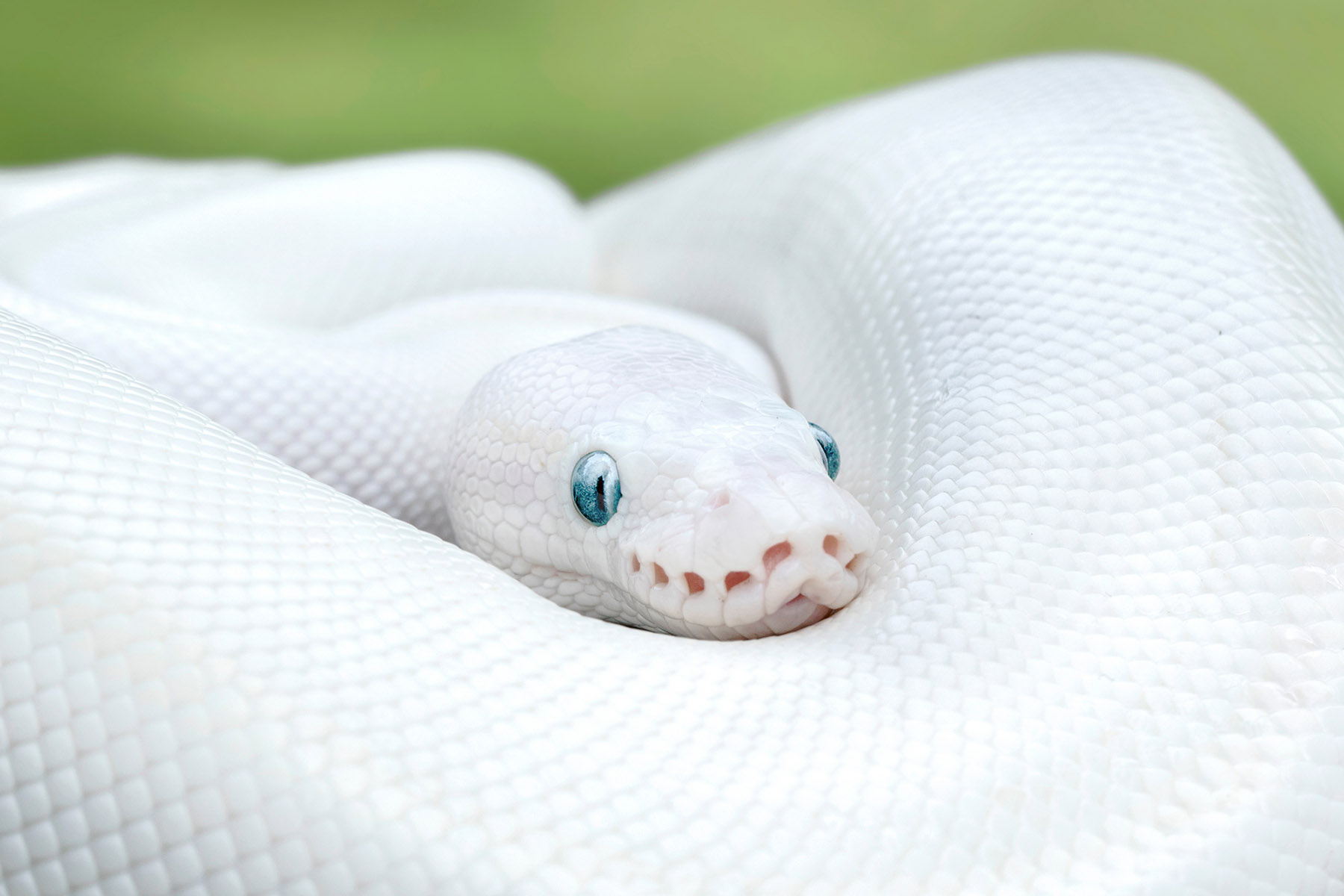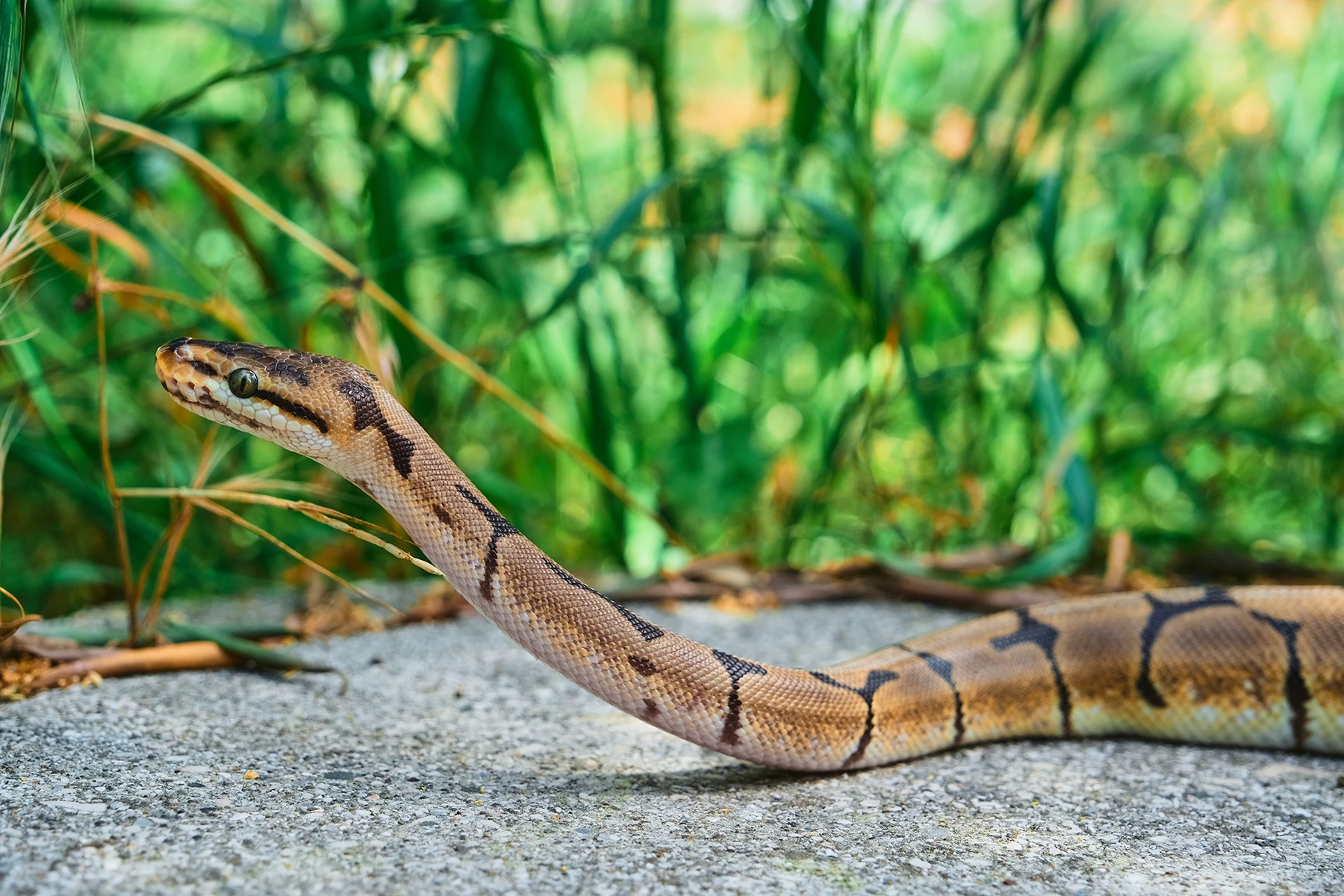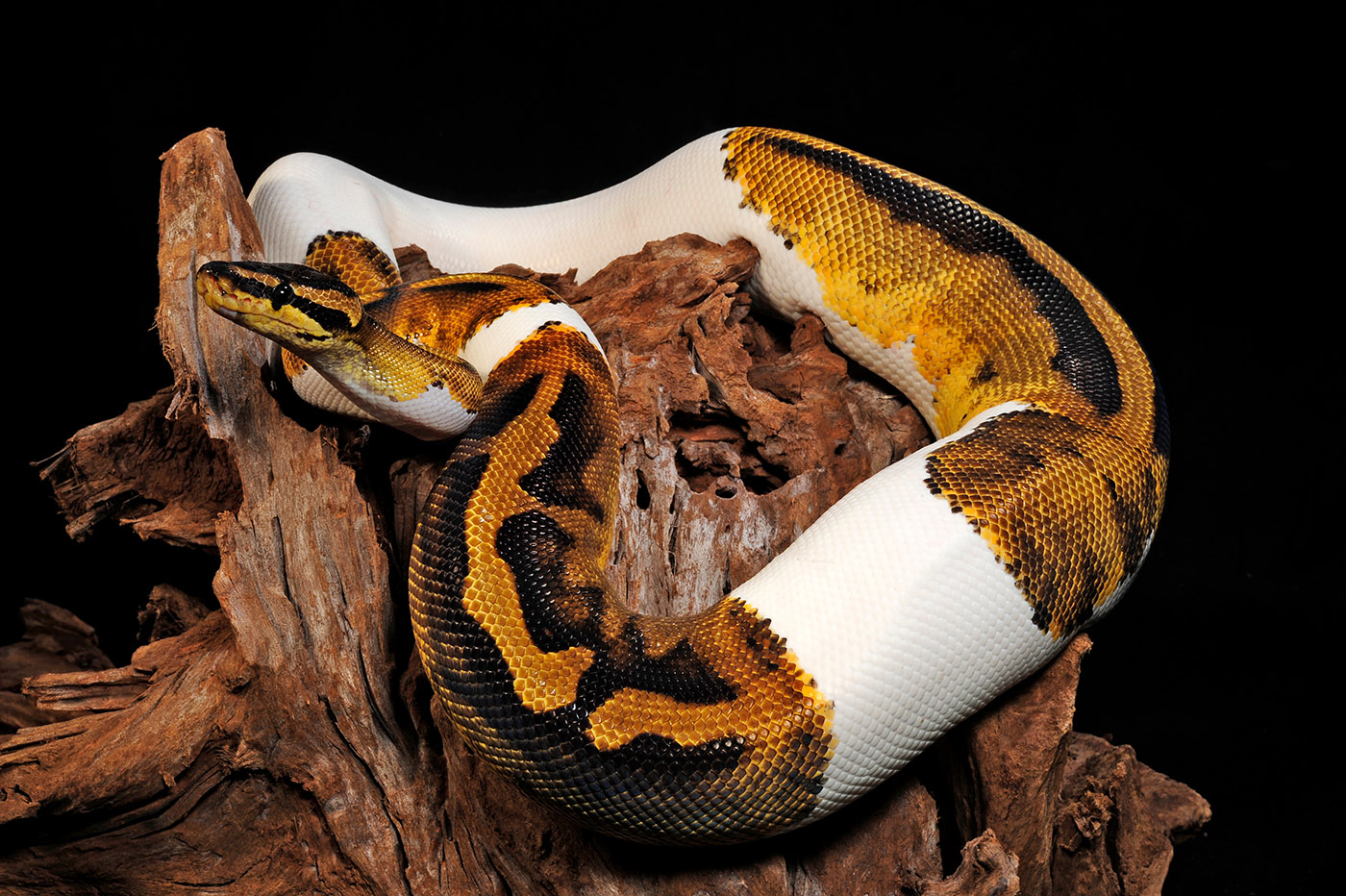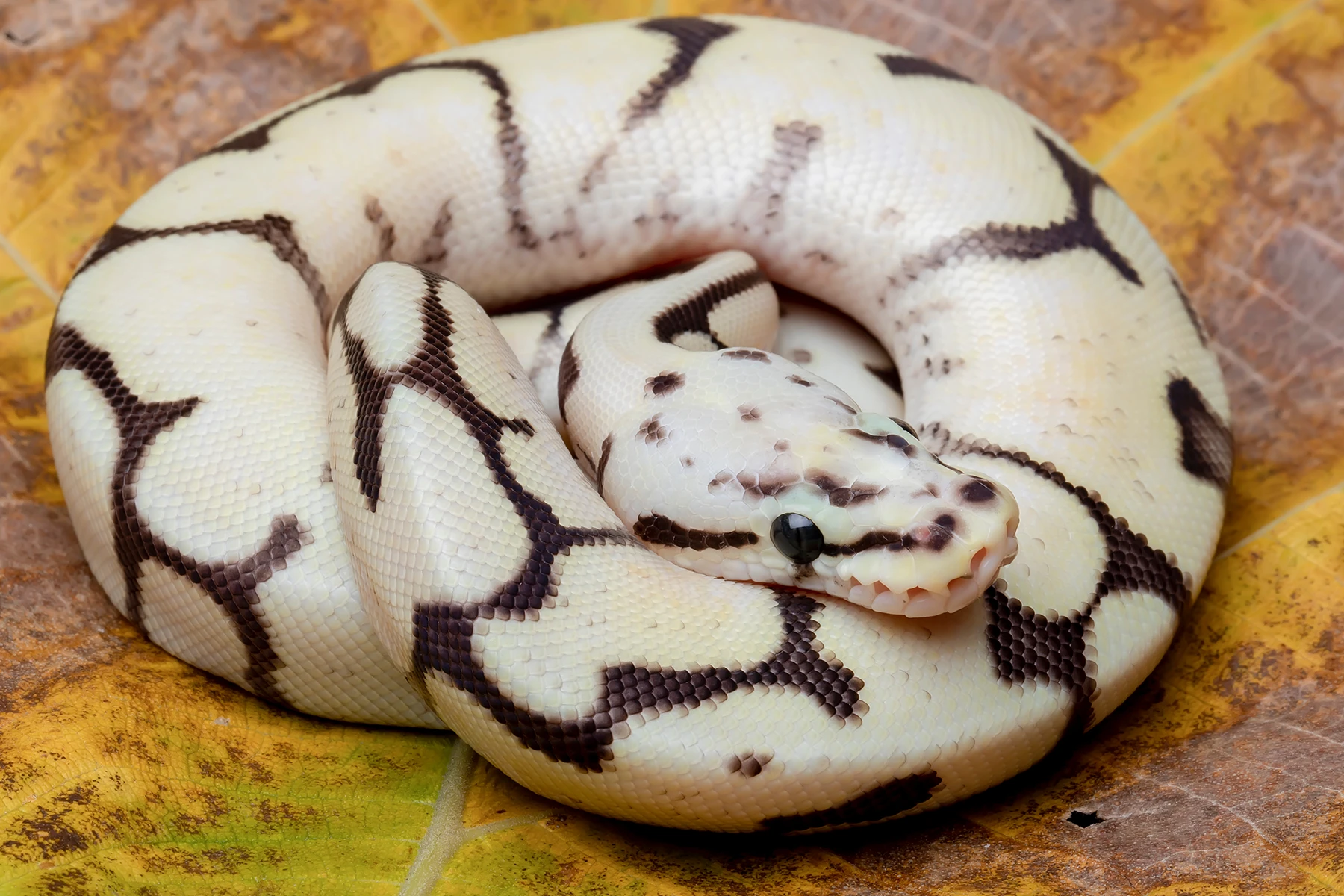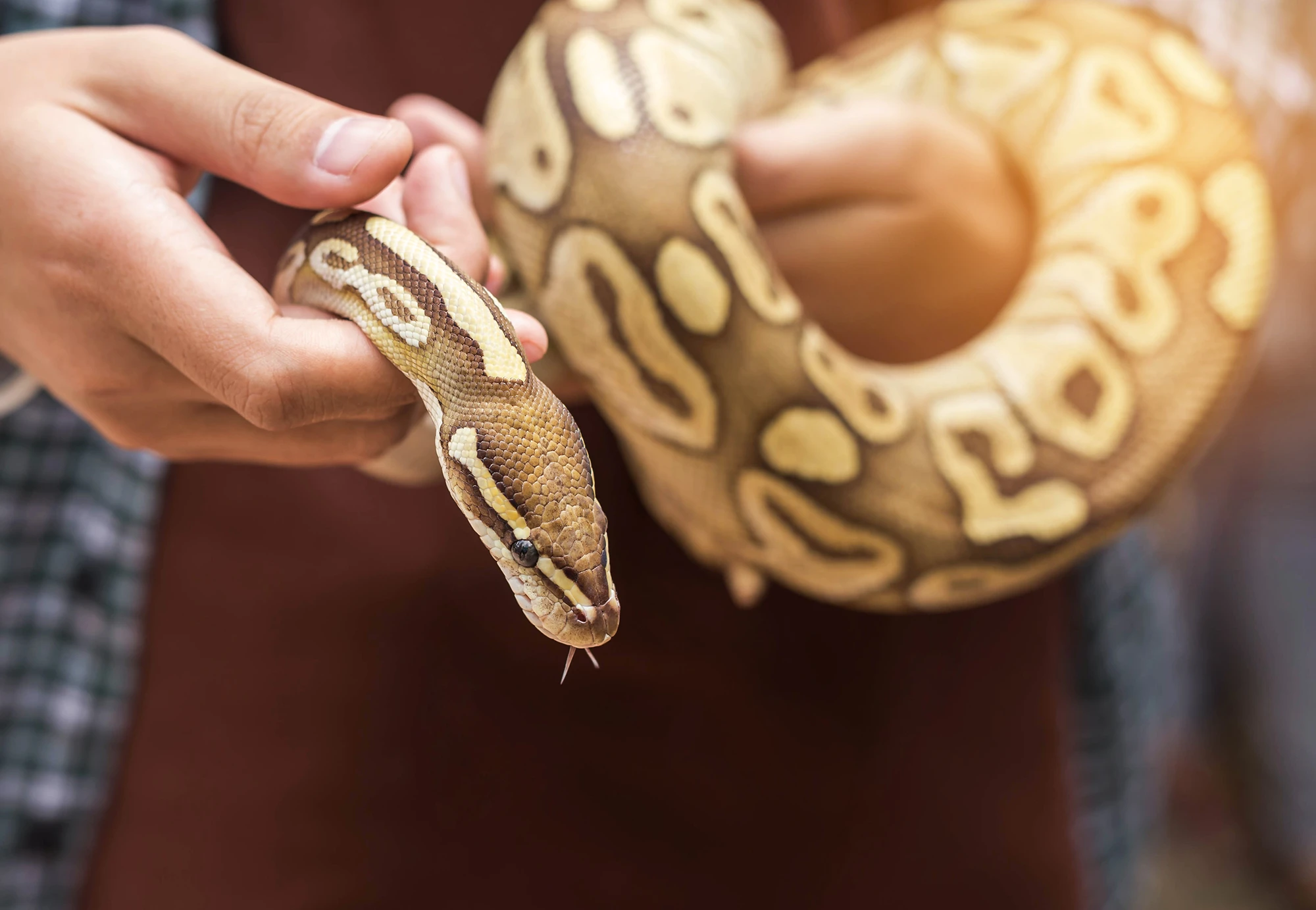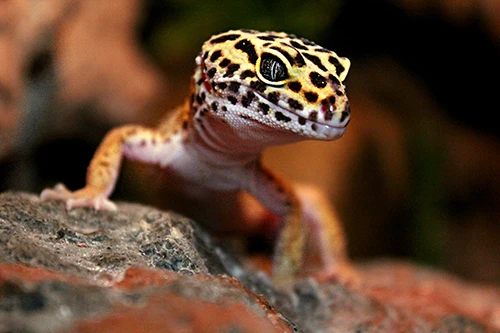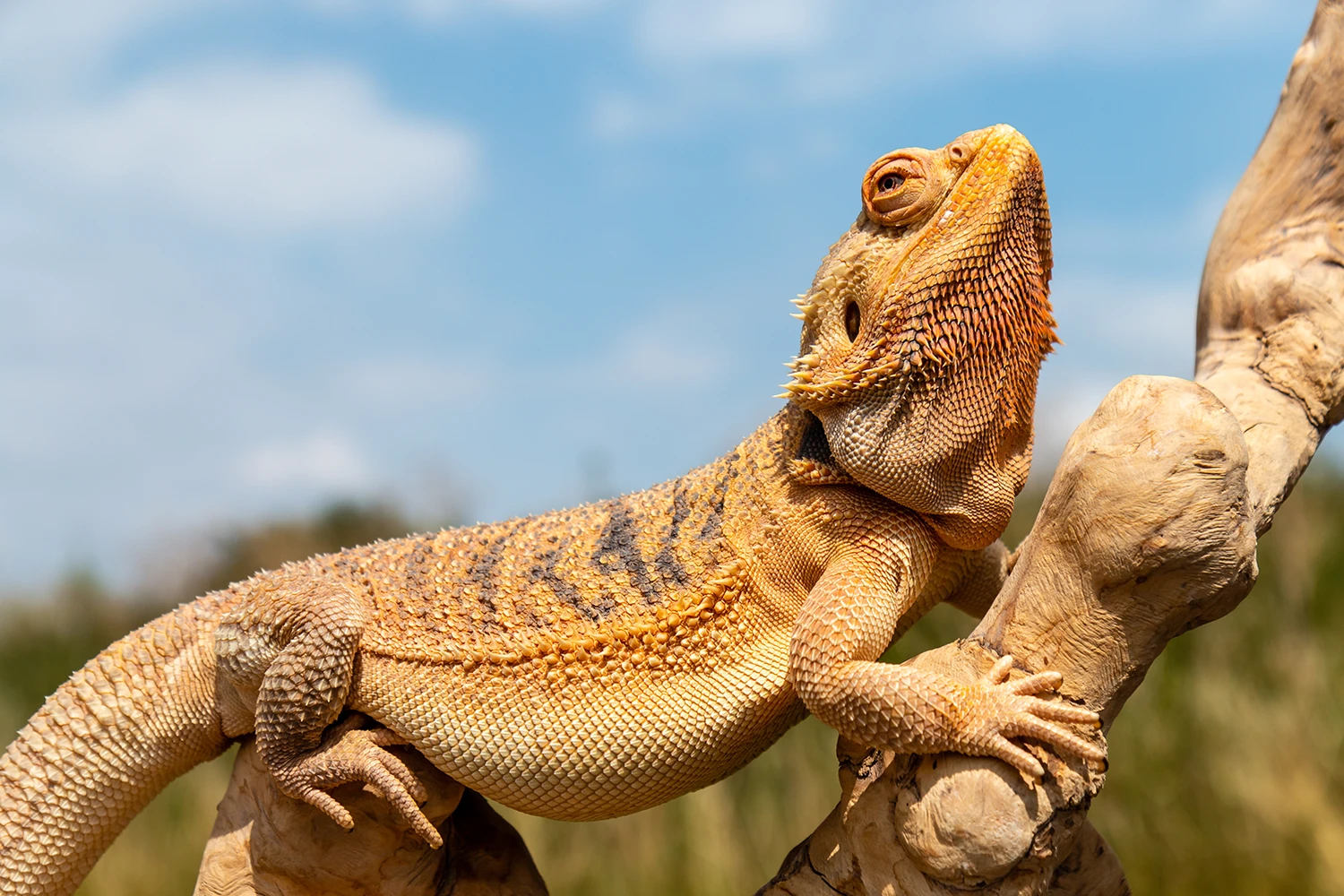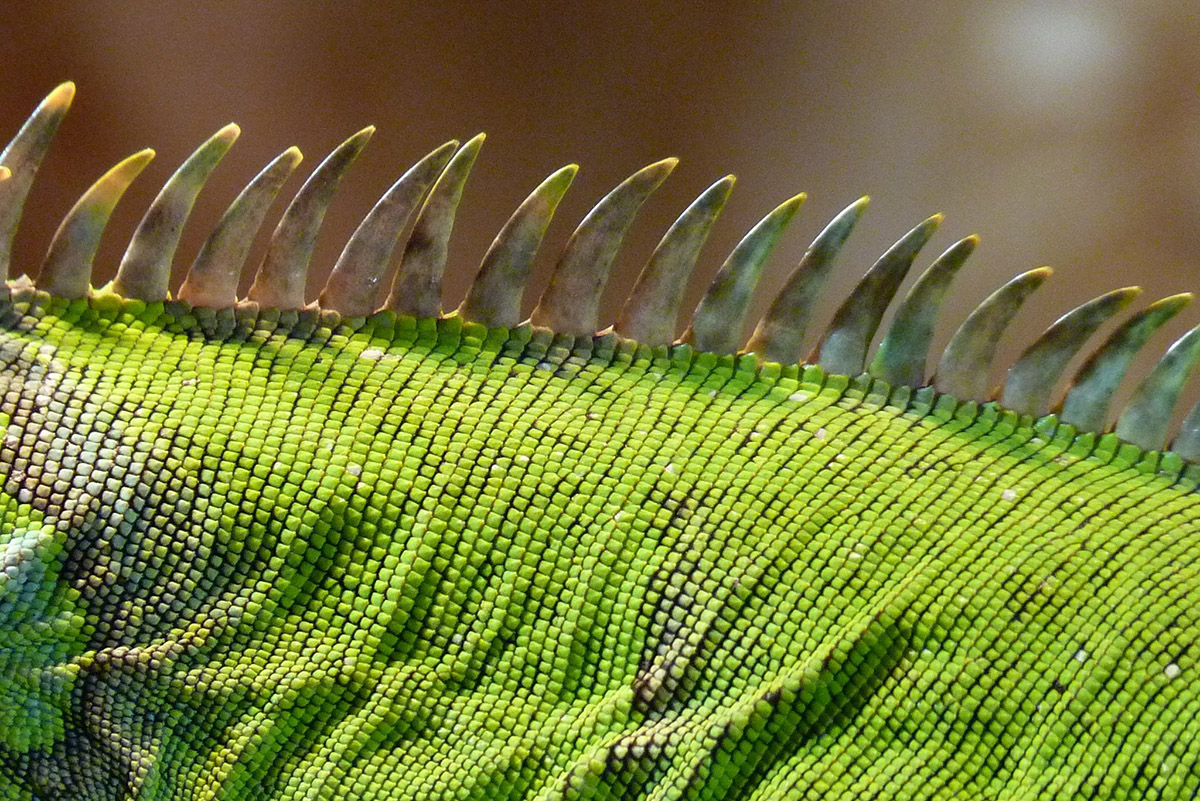

Ball Python Care guide
Origins: Africa – Diet: Carnivorous
Hailing from the grasslands of West and Central Africa, ball pythons are a captivating presence in the world of reptiles. Their natural habitats span savannas to sparse woodlands, where they’ve mastered the art of camouflage amidst earthy foliage. Renowned for their docile nature and the myriad of stunning morphs, they have secured a special place in the hearts of reptile enthusiasts. My connection to these magnificent creatures was solidified when I adopted Medusa, a “normal” morph with a name that precedes her. Through caring for her, I’ve come to deeply appreciate and understand the nuances of this remarkable species and hope our Ball Python Care Guide can help you.
Ball pythons are renowned for their calm and docile temperament, which makes them exceptionally well-suited as pets. These snakes are not prone to biting and are often quite tolerant of being handled, making them an excellent option for those looking to start a reptile-keeping journey. Their relaxed disposition also means they are less likely to become stressed or anxious when interacting with their owners. However, it’s important to remember that individual temperament can vary, and regular handling and a comfortable habitat are essential for maintaining their placid nature and ensuring a content life as a pet.
Caring for a ball python requires specific supplies to ensure their health, safety, and comfort. Here are some of the most important supplies you’ll need:
Enclosure: An appropriately sized tank or terrarium. For an adult ball python, the minimum size is generally around 40 gallons, but larger is often better. Alternatively, many keepers use plastic tubs or PVC reptile cages due to their ease of heating and cleaning.
Substrate: Aspen shavings, cypress mulch, coconut coir, or newspaper/paper towels are common choices. The substrate helps maintain humidity and should be spot-cleaned regularly and replaced periodically.
Heating: Under tank heaters (UTH) or heat tape for belly heat. Some also use ceramic heat emitters or radiant heat panels for ambient warmth. A regulated temperature gradient should be maintained.
Thermostat: An essential tool to regulate the heating elements, ensuring that the enclosure doesn’t get too hot or too cold.
Thermometers & Hygrometers: Instruments to measure and monitor the temperature and humidity levels within the enclosure.
Hide Boxes: At least two hide boxes – one for the warm side and one for the cool side of the enclosure. Ball pythons like to feel secure, and hides offer them a safe place to retreat.
Water Dish: A shallow, sturdy water dish large enough for the snake to soak if it wants to. Ensure the water is fresh and clean.
Humid Hide: Especially beneficial during shedding periods. This can be a box with moistened sphagnum moss or a similar material.
Climbing Branches & Decor: While not absolutely necessary, they can provide enrichment for your python. Ensure any decor is securely placed so it cannot fall and hurt the snake.
Lock or Clasp for Enclosure: To ensure the snake can’t escape and also for safety if there are other pets or young children in the home.
Feeding Tongs: Helpful for offering prey to your python, ensuring you don’t accidentally get bitten and that the snake associates the tongs, not your hand, with feeding time.
Snake Bag or Container: Useful for when you need to transport your snake or clean its enclosure.
Proper setup and regular maintenance of these supplies will ensure a comfortable and healthy environment for your ball python. Additionally, it’s essential to regularly check and replace equipment as needed, and always monitor the health and behavior of your snake.
One of the most important things to note when selecting the best substrate for a ball python is that they need a certain level of humidity, especially during shedding to be healthy. The substrate should help maintain appropriate humidity levels.
Cypress Mulch:
- Advantages: Retains moisture well, which can help maintain humidity. It also gives a natural look to the enclosure.
- Considerations: Ensure the mulch is free from pesticides, chemicals, or mold.
Coconut Coir or Coconut Husk:
- Advantages: Highly absorbent and excellent for maintaining humidity. It’s also eco-friendly and breaks down waste well.
- Considerations: It’s generally dust-free, but it’s a good practice to check for any mold or pests.
Newspaper or Paper Towels:
- Advantages: Inexpensive, easy to change out, and allows for easy monitoring of feces and urates.
- Considerations: Not visually appealing and doesn’t help much with humidity retention.
Orchid Bark:
- Advantages: Retains moisture and helps in maintaining humidity. Gives a natural look to the enclosure.
- Considerations: More expensive than some other substrates.
When choosing a substrate, avoid cedar or pine shavings, as they contain oils that can be harmful to reptiles.
Ball pythons are carnivorous reptiles that primarily consume small mammals and birds in the wild. For those kept in captivity, their diet typically consists of the following:
Rats: This is the most common food source for captive ball pythons. They can be fed frozen-thawed or live rats, depending on the snake’s preference and the owner’s comfort level. Starting with young ball pythons, many owners feed them appropriately sized mice or rat pups, gradually moving to larger rats as the python grows.
Mice: While mice can be a food source, especially for younger ball pythons, rats are generally more nutritious and filling for adult ball pythons. However, some snakes may prefer mice over rats.
When feeding ball pythons, please always be mindful of these considerations:
Size of Prey: The prey should be appropriately sized for the python, typically about the same width as the widest part of the snake’s body.
Frequency: Younger pythons typically eat once a week, while adults might eat every 10-14 days.
Frozen vs. Live: Many snake owners prefer to feed their pythons frozen-thawed prey because it’s safer (live rodents can bite or harm the snake) and more convenient. However, some snakes may prefer or only accept live prey.
Feeding Safety: If you choose to feed live prey (which Mister Reptile does not recommend), it’s essential to supervise the feeding to ensure the prey doesn’t harm the snake.
It’s important to note that ball pythons, especially in captivity, can sometimes be finicky eaters and may refuse food for various reasons, including stress, shedding, or temperature fluctuations. There have been reports of some snakes not eating for months at a time without suffering any major health issues. That being said, always monitor the snake’s health, weight, and behavior, and consult with a reptile veterinarian if there are concerns about its eating habits or overall health.
Defrosting frozen prey safely and effectively is crucial for the health of your ball python. Here’s a step-by-step guide to defrosting frozen rodents for your snake:
Plan Ahead: Take the frozen prey out of the freezer and place it in the refrigerator for a period of 12-24 hours. This allows for a slow and safe thawing process.
Warm Water Bath: After the prey has thawed in the refrigerator, you can speed up bringing it to an appropriate temperature by placing it in a sealed plastic bag and submerging it in warm (not hot) water for 15-30 minutes. Make sure the prey is in a waterproof bag to prevent it from getting wet, as water can wash away the rodent’s natural scent, making it less appealing to your snake.
Check the Temperature: Ensure the prey is warm throughout and not just on the surface. A cold center might deter your snake from eating, or, in worst cases, it can cause digestive issues. You can use tongs to handle the prey and gauge its warmth.
Do Not Use a Microwave: Microwaving can result in uneven heating, and hot spots can burn your snake’s mouth. It can also compromise the integrity of the rodent, making it burst or become messy.
Serve Promptly: Once the rodent is adequately warmed, it should be offered to the snake promptly. A delay can result in the prey cooling down too much, which might make it less appealing.
Observe Your Snake: The first few times you offer thawed prey, it’s essential to observe to ensure the snake is receptive to it. Some snakes might be hesitant at first but can usually be conditioned to accept thawed prey over time.
Avoid Refreezing: Once you’ve thawed the prey, do not refreeze it if your snake doesn’t eat it. Dispose of it properly.
Safety and cleanliness are key. Always wash your hands thoroughly after handling frozen prey, and ensure the area you used for thawing is cleaned and sanitized.
Bearded dragons are popular pets for their friendly nature, manageable size, and long lifespan (up to 15 years). They come in various colors and patterns, making them visually appealing. They’re low-maintenance, quiet, and odorless. Bearded dragons are interactive and can be trained. They offer educational benefits and can be therapeutic for some owners. However, they require a proper habitat, varied diet, and regular care to thrive.
When considering acquiring a ball python, it’s essential to ensure the source prioritizes the well-being and health of the animals. Here’s a list of recommended places, starting with the most preferred options:
- Local Pet Stores:
- Advantages: Supporting local businesses is always good, and some local pet stores may have deep connections with reputable breeders.
- Considerations: Ensure the store has knowledgeable staff and that the animals are kept in clean, appropriate conditions.
- Rescue Organizations or Adoption:
- Advantages: Adopting a ball python gives a snake a second chance at a loving home. Rescue organizations will also ensure the snake is in good health before adoption.
- Considerations: The python’s history might not always be clear, especially concerning its age or genetics.
- Reputable Breeders:
- Advantages: Dedicated breeders often have a deep knowledge of ball pythons, their lineage, and any potential health issues. They can provide details about the python’s genetics, especially if you’re interested in specific morphs.
- Considerations: Do your research, ask for references, and possibly visit their breeding facility if possible.
- Reptile Expos or Shows:
- Advantages: These events gather multiple breeders and enthusiasts. It’s an opportunity to see a variety of ball pythons, compare prices, and get firsthand knowledge.
- Considerations: Make sure to research the breeders present at the expo and ask questions. Not all vendors at expos are equally reputable.
- Chain Pet Stores:
- Advantages: They are easily accessible and can offer guarantees on the health of the animal.
- Considerations: Unfortunately, not all chain stores provide optimal care or conditions for their reptiles. They might also not have specifics on the python’s lineage or detailed health history.
Regardless of the source, always prioritize the snake’s health and well-being. Before purchasing or adopting, check for clear eyes, healthy skin, and signs of regular feeding. Ensure you ask questions, understand the snake’s history, and are prepared with the appropriate setup at home.
Origins: Africa – Diet: Carnivorous
Hailing from the grasslands of West and Central Africa, ball pythons are a captivating presence in the world of reptiles. Their natural habitats span savannas to sparse woodlands, where they’ve mastered the art of camouflage amidst earthy foliage. Renowned for their docile nature and the myriad of stunning morphs, they have secured a special place in the hearts of reptile enthusiasts. My connection to these magnificent creatures was solidified when I adopted Medusa, a “normal” morph with a name that precedes her. Through caring for her, I’ve come to deeply appreciate and understand the nuances of this remarkable species and hope our Ball Python Care Guide can help you.
Ball pythons are renowned for their calm and docile temperament, which makes them exceptionally well-suited as pets. These snakes are not prone to biting and are often quite tolerant of being handled, making them an excellent option for those looking to start a reptile-keeping journey. Their relaxed disposition also means they are less likely to become stressed or anxious when interacting with their owners. However, it’s important to remember that individual temperament can vary, and regular handling and a comfortable habitat are essential for maintaining their placid nature and ensuring a content life as a pet.
Caring for a ball python requires specific supplies to ensure their health, safety, and comfort. Here are some of the most important supplies you’ll need:
Enclosure: An appropriately sized tank or terrarium. For an adult ball python, the minimum size is generally around 40 gallons, but larger is often better. Alternatively, many keepers use plastic tubs or PVC reptile cages due to their ease of heating and cleaning.
Substrate: Aspen shavings, cypress mulch, coconut coir, or newspaper/paper towels are common choices. The substrate helps maintain humidity and should be spot-cleaned regularly and replaced periodically.
Heating: Under tank heaters (UTH) or heat tape for belly heat. Some also use ceramic heat emitters or radiant heat panels for ambient warmth. A regulated temperature gradient should be maintained.
Thermostat: An essential tool to regulate the heating elements, ensuring that the enclosure doesn’t get too hot or too cold.
Thermometers & Hygrometers: Instruments to measure and monitor the temperature and humidity levels within the enclosure.
Hide Boxes: At least two hide boxes – one for the warm side and one for the cool side of the enclosure. Ball pythons like to feel secure, and hides offer them a safe place to retreat.
Water Dish: A shallow, sturdy water dish large enough for the snake to soak if it wants to. Ensure the water is fresh and clean.
Humid Hide: Especially beneficial during shedding periods. This can be a box with moistened sphagnum moss or a similar material.
Climbing Branches & Decor: While not absolutely necessary, they can provide enrichment for your python. Ensure any decor is securely placed so it cannot fall and hurt the snake.
Lock or Clasp for Enclosure: To ensure the snake can’t escape and also for safety if there are other pets or young children in the home.
Feeding Tongs: Helpful for offering prey to your python, ensuring you don’t accidentally get bitten and that the snake associates the tongs, not your hand, with feeding time.
Snake Bag or Container: Useful for when you need to transport your snake or clean its enclosure.
Proper setup and regular maintenance of these supplies will ensure a comfortable and healthy environment for your ball python. Additionally, it’s essential to regularly check and replace equipment as needed, and always monitor the health and behavior of your snake.
One of the most important things to note when selecting the best substrate for a ball python is that they need a certain level of humidity, especially during shedding to be healthy. The substrate should help maintain appropriate humidity levels.
Cypress Mulch:
- Advantages: Retains moisture well, which can help maintain humidity. It also gives a natural look to the enclosure.
- Considerations: Ensure the mulch is free from pesticides, chemicals, or mold.
Coconut Coir or Coconut Husk:
- Advantages: Highly absorbent and excellent for maintaining humidity. It’s also eco-friendly and breaks down waste well.
- Considerations: It’s generally dust-free, but it’s a good practice to check for any mold or pests.
Newspaper or Paper Towels:
- Advantages: Inexpensive, easy to change out, and allows for easy monitoring of feces and urates.
- Considerations: Not visually appealing and doesn’t help much with humidity retention.
Orchid Bark:
- Advantages: Retains moisture and helps in maintaining humidity. Gives a natural look to the enclosure.
- Considerations: More expensive than some other substrates.
When choosing a substrate, avoid cedar or pine shavings, as they contain oils that can be harmful to reptiles.
Ball pythons are carnivorous reptiles that primarily consume small mammals and birds in the wild. For those kept in captivity, their diet typically consists of the following:
Rats: This is the most common food source for captive ball pythons. They can be fed frozen-thawed or live rats, depending on the snake’s preference and the owner’s comfort level. Starting with young ball pythons, many owners feed them appropriately sized mice or rat pups, gradually moving to larger rats as the python grows.
Mice: While mice can be a food source, especially for younger ball pythons, rats are generally more nutritious and filling for adult ball pythons. However, some snakes may prefer mice over rats.
When feeding ball pythons, please always be mindful of these considerations:
Size of Prey: The prey should be appropriately sized for the python, typically about the same width as the widest part of the snake’s body.
Frequency: Younger pythons typically eat once a week, while adults might eat every 10-14 days.
Frozen vs. Live: Many snake owners prefer to feed their pythons frozen-thawed prey because it’s safer (live rodents can bite or harm the snake) and more convenient. However, some snakes may prefer or only accept live prey.
Feeding Safety: If you choose to feed live prey (which Mister Reptile does not recommend), it’s essential to supervise the feeding to ensure the prey doesn’t harm the snake.
It’s important to note that ball pythons, especially in captivity, can sometimes be finicky eaters and may refuse food for various reasons, including stress, shedding, or temperature fluctuations. There have been reports of some snakes not eating for months at a time without suffering any major health issues. That being said, always monitor the snake’s health, weight, and behavior, and consult with a reptile veterinarian if there are concerns about its eating habits or overall health.
Defrosting frozen prey safely and effectively is crucial for the health of your ball python. Here’s a step-by-step guide to defrosting frozen rodents for your snake:
Plan Ahead: Take the frozen prey out of the freezer and place it in the refrigerator for a period of 12-24 hours. This allows for a slow and safe thawing process.
Warm Water Bath: After the prey has thawed in the refrigerator, you can speed up bringing it to an appropriate temperature by placing it in a sealed plastic bag and submerging it in warm (not hot) water for 15-30 minutes. Make sure the prey is in a waterproof bag to prevent it from getting wet, as water can wash away the rodent’s natural scent, making it less appealing to your snake.
Check the Temperature: Ensure the prey is warm throughout and not just on the surface. A cold center might deter your snake from eating, or, in worst cases, it can cause digestive issues. You can use tongs to handle the prey and gauge its warmth.
Do Not Use a Microwave: Microwaving can result in uneven heating, and hot spots can burn your snake’s mouth. It can also compromise the integrity of the rodent, making it burst or become messy.
Serve Promptly: Once the rodent is adequately warmed, it should be offered to the snake promptly. A delay can result in the prey cooling down too much, which might make it less appealing.
Observe Your Snake: The first few times you offer thawed prey, it’s essential to observe to ensure the snake is receptive to it. Some snakes might be hesitant at first but can usually be conditioned to accept thawed prey over time.
Avoid Refreezing: Once you’ve thawed the prey, do not refreeze it if your snake doesn’t eat it. Dispose of it properly.
Safety and cleanliness are key. Always wash your hands thoroughly after handling frozen prey, and ensure the area you used for thawing is cleaned and sanitized.
Bearded dragons are popular pets for their friendly nature, manageable size, and long lifespan (up to 15 years). They come in various colors and patterns, making them visually appealing. They’re low-maintenance, quiet, and odorless. Bearded dragons are interactive and can be trained. They offer educational benefits and can be therapeutic for some owners. However, they require a proper habitat, varied diet, and regular care to thrive.
When considering acquiring a ball python, it’s essential to ensure the source prioritizes the well-being and health of the animals. Here’s a list of recommended places, starting with the most preferred options:
- Local Pet Stores:
- Advantages: Supporting local businesses is always good, and some local pet stores may have deep connections with reputable breeders.
- Considerations: Ensure the store has knowledgeable staff and that the animals are kept in clean, appropriate conditions.
- Rescue Organizations or Adoption:
- Advantages: Adopting a ball python gives a snake a second chance at a loving home. Rescue organizations will also ensure the snake is in good health before adoption.
- Considerations: The python’s history might not always be clear, especially concerning its age or genetics.
- Reputable Breeders:
- Advantages: Dedicated breeders often have a deep knowledge of ball pythons, their lineage, and any potential health issues. They can provide details about the python’s genetics, especially if you’re interested in specific morphs.
- Considerations: Do your research, ask for references, and possibly visit their breeding facility if possible.
- Reptile Expos or Shows:
- Advantages: These events gather multiple breeders and enthusiasts. It’s an opportunity to see a variety of ball pythons, compare prices, and get firsthand knowledge.
- Considerations: Make sure to research the breeders present at the expo and ask questions. Not all vendors at expos are equally reputable.
- Chain Pet Stores:
- Advantages: They are easily accessible and can offer guarantees on the health of the animal.
- Considerations: Unfortunately, not all chain stores provide optimal care or conditions for their reptiles. They might also not have specifics on the python’s lineage or detailed health history.
Regardless of the source, always prioritize the snake’s health and well-being. Before purchasing or adopting, check for clear eyes, healthy skin, and signs of regular feeding. Ensure you ask questions, understand the snake’s history, and are prepared with the appropriate setup at home.
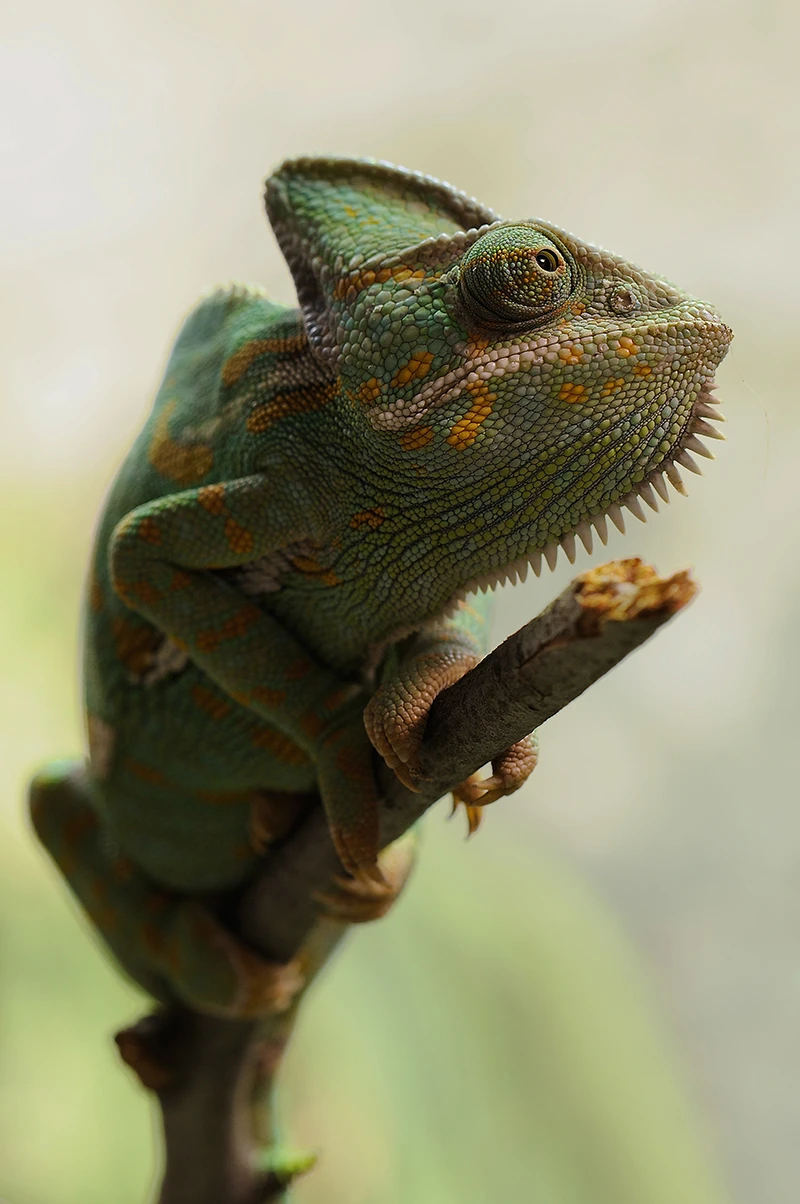
Reminder! We are not veternarians. Please consult multiple others
This website provides information on pet care and related topics with content generated by a combination of AI technology and contributions from everyday individuals. However, it is important to understand that the information presented here should not be considered a substitute for professional veterinary advice, diagnosis, or treatment. The content on this website is intended for general informational purposes only.
Always consult a qualified veterinarian or pet care expert for guidance on your pet’s health and well-being. Your pet’s health and safety should be your top priority, and this website should be used as a supplementary source of information.
More animal care guides
© 2023 Mister Reptile. All rights reserved. / Privacy / Terms of Use / Cookie preferences / Do not sell or share my personal information
